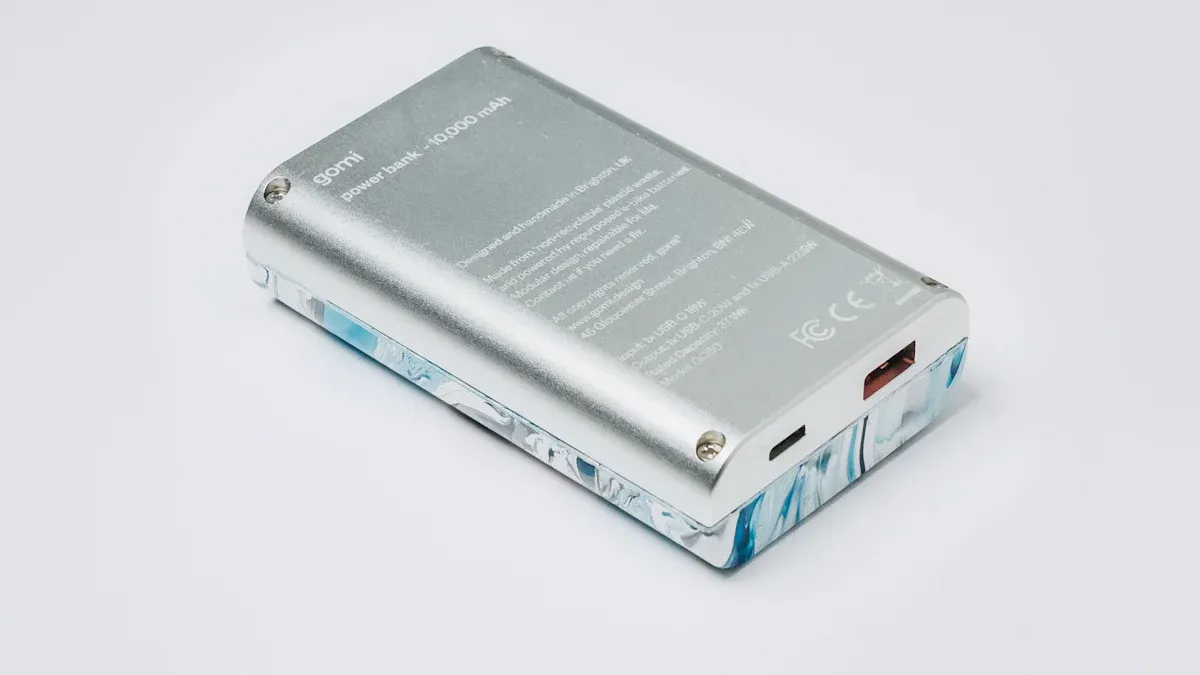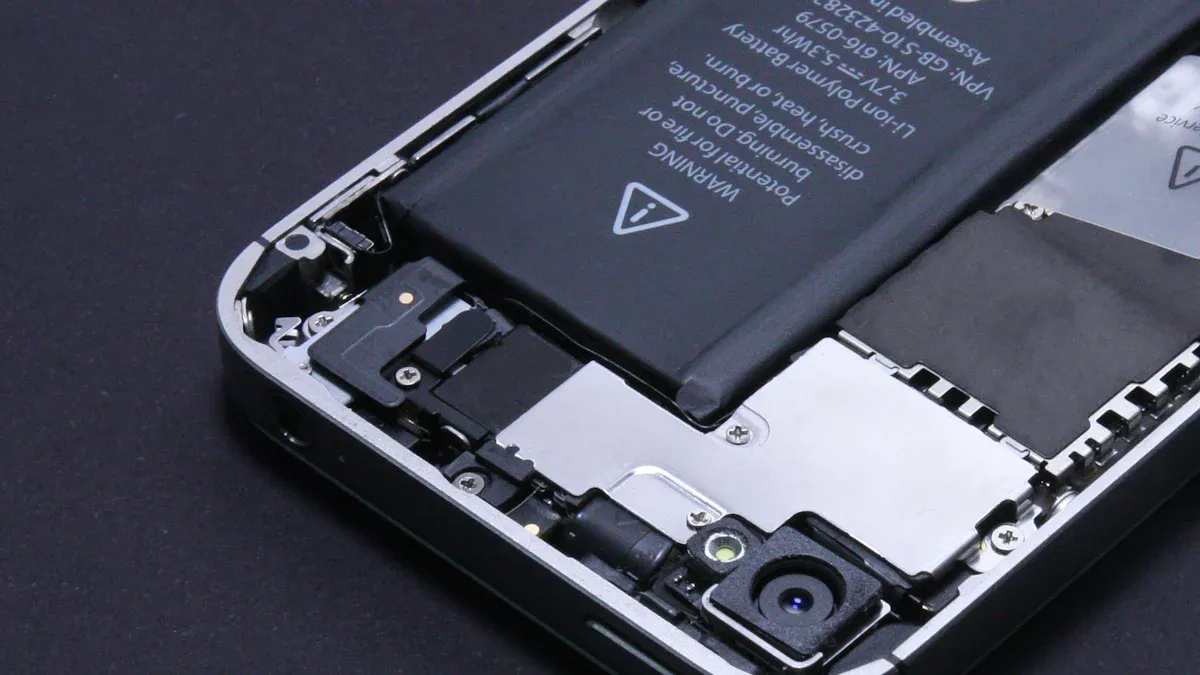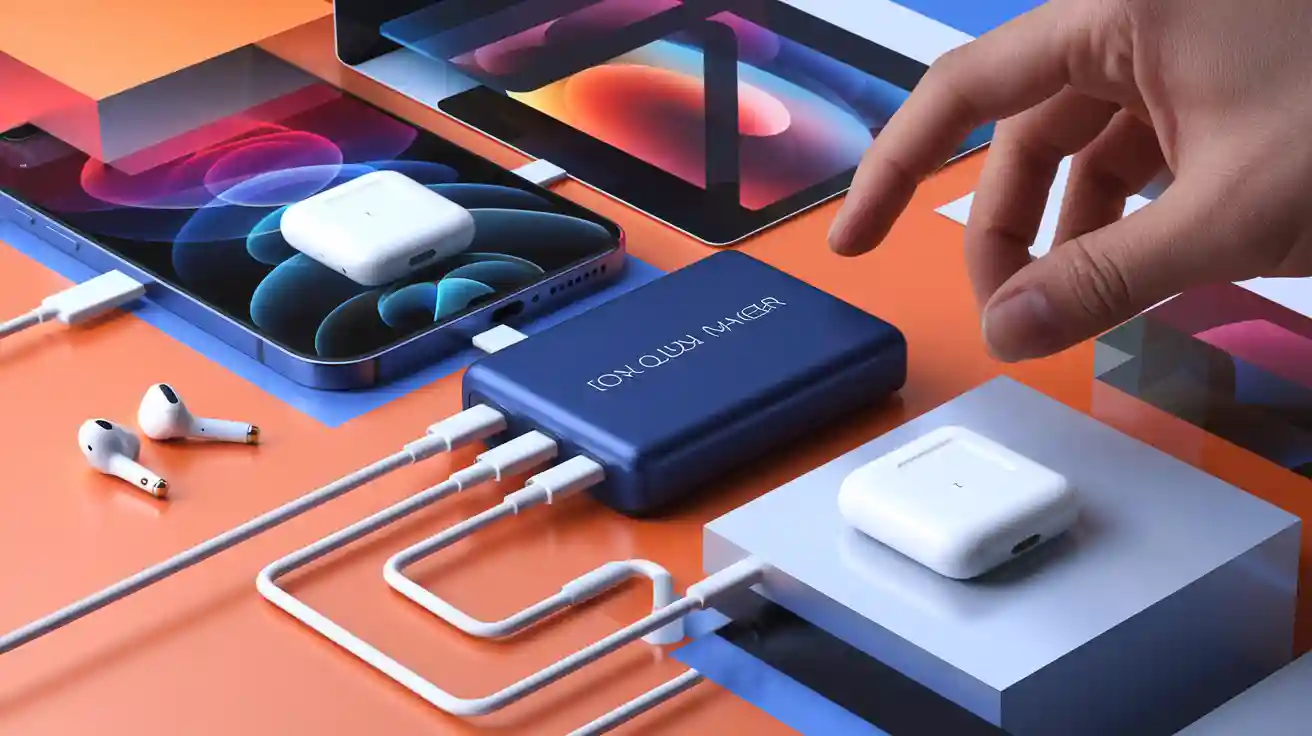Polymer lithium ion batteries power your favorite devices
You rely on polymer lithium ion batteries every day, often without realizing it. These advanced batteries power the smartphones in your pocket, the laptops on your desk, and the wearables you use to track your health. Their popularity comes from their lightweight, flexible design and impressive energy efficiency.
| Device Type | Usage of Polymer Lithium Ion Batteries | Reason for Popularity |
|---|---|---|
| Smartphones | Yes | Lightweight and compact |
| Laptops | Yes | Ultra-thin form factor |
| Tablets | Yes | Portability and efficiency |
| Wearable Devices | Yes | Flexibility and reduced weight |
Key Takeaways
- Polymer lithium ion batteries are lightweight and flexible, making them ideal for portable devices like smartphones and wearables.
- These batteries offer enhanced safety features, reducing the risk of overheating and failure, which is crucial for medical devices.
- Their high energy density allows for longer usage times, meaning you can enjoy your devices without frequent recharging.
- Fast charging capabilities minimize downtime, ensuring your devices are ready to use when you need them.
- The flexible design of polymer lithium ion batteries supports innovative product designs, allowing manufacturers to create slimmer and more comfortable devices.
What are polymer lithium ion batteries?

Definition
You encounter polymer lithium ion batteries in many of your favorite devices. These batteries use lithium-ion technology, but they stand out because of their unique electrolyte. Instead of a liquid electrolyte found in traditional lithium-ion batteries, polymer lithium ion batteries use a solid or semi-solid polymer electrolyte. This difference changes the structure and performance of the battery. The polymer material allows for a thinner, lighter, and more flexible battery design. You benefit from this technology every time you pick up a slim smartphone or a lightweight wearable.
Note: The solid or gel-like electrolyte in polymer lithium ion batteries makes them safer and more adaptable for modern electronics.
Key features
Polymer lithium ion batteries offer several advantages over traditional lithium-ion batteries. The table below highlights the main differences:
| Feature | Lithium-Ion Batteries | Lithium Polymer Batteries |
|---|---|---|
| Composition | Liquid electrolytes in cylindrical shape | Polymer gel electrolytes in flexible casing |
| Energy Density | Higher energy density, more energy in less space | Lower energy density, larger size for less energy |
| Charging Time | Faster charging due to liquid electrolytes | Slower charging due to gel-like electrolytes |
| Safety | More sensitive to overcharging and temperature | More stable, less likely to catch fire |
You notice that polymer lithium ion batteries provide flexibility and safety. Manufacturers choose them for devices that need a slim profile or unique shapes. You also experience fewer safety risks, as these batteries are less likely to overheat or catch fire. While they may not always offer the highest energy density, their design makes them ideal for portable electronics.
Device applications

Consumer electronics
You interact with polymer lithium ion batteries every time you use your favorite gadgets. These batteries power a wide range of consumer electronics, making your devices lighter and more portable. You find them in smartphones, tablets, laptops, and wearables. Wireless earbuds, drones, portable gaming consoles, and e-readers also rely on this technology. Manufacturers choose polymer lithium ion batteries because they allow for slim designs and flexible shapes. You benefit from longer battery life and faster charging, which improves your daily experience.
Tip: Devices with polymer lithium ion batteries often feel lighter and more comfortable to carry, making them ideal for travel and everyday use.
Medical and health devices
Polymer lithium ion batteries play a critical role in medical and health devices. You depend on these batteries for reliable performance in life-saving equipment and portable diagnostic tools. Their lightweight and flexible nature makes them suitable for compact medical devices that require consistent power.
- Implantable Medical Devices: Pacemakers, implantable cardioverter-defibrillators (ICDs), neurostimulators, and cochlear implants.
- Portable Medical Devices: Blood glucose meters, infusion pumps, portable oxygen concentrators, and electronic thermometers.
- Diagnostic Equipment: Portable ultrasound machines, handheld ECG monitors, and pulse oximeters.
- Medical Imaging Equipment: Handheld ultrasound scanners, portable X-ray machines, and mobile CT scanners.
- Electric Wheelchairs and Mobility Aids: Electric wheelchairs and mobility scooters.
Polymer lithium ion batteries in medical devices meet strict safety and performance standards. You can trust these batteries because they include features like overcharge protection and thermal shutdown. Manufacturers follow rigorous quality control and regulatory requirements, which ensures reliability in critical applications. These safety measures reduce risks and provide peace of mind for both patients and healthcare professionals.
Environmental and industrial uses
You see polymer lithium ion batteries powering devices beyond consumer and medical electronics. Environmental monitoring and industrial automation rely on these batteries for consistent and reliable energy. Their lightweight design and flexibility make them ideal for remote and portable equipment.
| Device Type | Description |
|---|---|
| Environmental Monitoring | Air quality sensors, weather stations, and water quality monitors powered by IoT batteries. |
Industrial IoT devices increasingly use polymer lithium ion batteries because of their reliability and steady power output. You notice this trend in robotics, power tools, and automated systems. The demand for these batteries continues to grow as industries adopt more automation. Polymer lithium ion batteries outperform other battery technologies in many industrial applications, supporting innovation and efficiency.
Benefits of polymer lithium ion batteries
Lightweight design
You notice the difference every time you pick up a modern device. Polymer lithium ion batteries use a polymer electrolyte instead of a liquid one, which makes them lighter. The flexible architecture allows manufacturers to create batteries that weigh less than traditional lithium-ion options. Devices like smartphones and wearables benefit from this reduced weight, making them easier to carry and use throughout your day.
- Polymer electrolytes contribute to lighter battery weight.
- Flexible battery structures reduce overall device weight.
- Lighter batteries are ideal for applications where space and weight matter most.
The lightweight design enables thinner constructions, which means less material in your devices. You enjoy enhanced portability and a high energy-to-weight ratio, so your devices feel lighter and perform better.
Flexibility
Polymer lithium ion batteries offer unmatched flexibility in design. You see this advantage in devices that bend, fold, or fit into tight spaces. Manufacturers can shape these batteries to fit curved surfaces or compact compartments, which opens up new possibilities for product innovation.
- Flexible batteries bend and fold to fit various shapes.
- Adaptable designs suit wearables, smartwatches, and fitness bands.
- Batteries conform to body movements, improving comfort and durability.
- Foldable smartphones and tablets rely on batteries that bend without damage.
You benefit from sleeker, more comfortable devices that match your lifestyle. Flexible batteries make it possible for technology to adapt to your needs.
High energy density
Energy density measures how much power a battery stores in a given space. Polymer lithium ion batteries deliver impressive energy density, which translates to longer usage times for your devices. You spend less time charging and more time using your favorite electronics.
| Battery Type | Energy Density (Wh/kg) | Energy Density (Wh/L) |
|---|---|---|
| Lithium-ion | 150-250 | 300-700 |
| Lithium-polymer | 100-200 | 200-400 |
Higher capacity means more energy storage. You experience extended usage between charges, which is especially important for portable electronics and electric vehicles. The compact size and high energy density allow your devices to operate longer without frequent recharging.
Safety
Safety remains a top priority for battery technology. Polymer lithium ion batteries include advanced features to protect you and your devices from overheating and failure.
- Overcharge protection shuts down or reduces current at safe voltage levels.
- Temperature control monitors heat and triggers shutdown if needed.
- Current limiting prevents excessive charging or discharging.
- Short circuit protection cuts power instantly during faults.
- Over-discharge protection keeps voltage within safe limits.
- Thermal management uses cooling solutions to control heat.
- Cell balancing ensures even charge distribution.
- Integrated circuits add extra safety layers.
- Battery management systems track temperature, voltage, and current.
Manufacturers design these batteries to meet strict safety standards. You can trust your devices to perform reliably, with lower risks of swelling, overheating, or other failures.
User experience
Battery life
You expect your devices to last throughout the day. Polymer lithium ion batteries deliver longer battery life for wearables and portable electronics. Their high energy density means you spend less time searching for a charger and more time using your favorite gadgets. The table below highlights how these batteries improve your experience:
| Feature | Benefit |
|---|---|
| Lightweight | Reduces overall device weight, enhancing portability |
| Flexible design | Allows integration into various device shapes and sizes |
| High energy density | Provides longer usage periods without frequent recharging |
| Thin profile | Maintains compact form factor in wearables and portable electronics |
You notice that your smartwatch, fitness tracker, or wireless earbuds run longer between charges. This improvement comes from the efficient energy storage and delivery of polymer lithium ion batteries.
Portability
You want devices that fit your lifestyle and move with you. Polymer lithium ion batteries make this possible by enabling slimmer, lighter, and more portable designs. You benefit from:
- Thin and lightweight form factor
- Ideal fit for smartphones, tablets, and wearables
- Flexible electrolytes that conform to unique device shapes
These batteries allow manufacturers to create products that slip easily into your pocket or bag. You enjoy greater freedom and convenience, whether you travel, exercise, or work on the go.
Devices powered by these batteries feel lighter and more comfortable, making them perfect for daily use.
You also see that their flexible pouch design lets them fit into tight spaces, optimizing every millimeter inside your device.
Fast charging
You value quick charging times. Polymer lithium ion batteries support faster charging, so your devices spend less time plugged in. The table below shows typical charging times:
| Battery Type | Recommended Charging Time |
|---|---|
| Lithium polymer (LiPo) | 3-5 hours |
| Mobile phone battery | 1-3 hours |
| Larger batteries (laptops, EVs) | 4-6 hours |
- Lower internal resistance enables faster charging rates.
- Reduced downtime means your devices are ready when you need them.
- Increased device availability boosts your satisfaction and productivity.
You experience less waiting and more doing, thanks to the advanced charging capabilities of these batteries.
Polymer lithium ion batteries power your favorite devices and drive innovation across many industries. You benefit from longer battery life, lighter designs, and safer technology every day. Industry experts highlight several trends shaping the future:
- Continuous innovation will expand adoption in consumer technology.
- Demand for lightweight, flexible power solutions is rising.
- Advancements in battery lifespan and energy density remain crucial.
- Integration with renewable energy and smart grids supports growth.
Manufacturers face challenges, including complex recycling and strict certification processes. You can appreciate how these batteries enhance your daily experience and support the next generation of technology.
FAQ
What makes polymer lithium ion batteries different from regular lithium-ion batteries?
Polymer lithium ion batteries use a flexible polymer electrolyte instead of a liquid one. You get lighter, thinner, and safer batteries. Manufacturers can shape them to fit unique device designs.
Can you recycle polymer lithium ion batteries?
Yes, you can recycle these batteries. Specialized recycling centers handle them safely. Always follow local guidelines for battery disposal to protect the environment.
Are polymer lithium ion batteries safe for medical devices?
You can trust these batteries in medical devices. They include safety features like overcharge protection and thermal management. Manufacturers test them to meet strict health and safety standards.
How long do polymer lithium ion batteries last?
You can expect these batteries to last two to three years with regular use. Proper charging and storage help extend their lifespan. Always avoid extreme temperatures for best results.
Do polymer lithium ion batteries support fast charging?
Many polymer lithium ion batteries support fast charging. You benefit from reduced charging times and increased device availability. Always use the recommended charger for your device.
-

 May.2025.11.24Ternary Lithium Battery vs Lithium-ion: Complete Comparison Guide (2025 Edition)Learn More
May.2025.11.24Ternary Lithium Battery vs Lithium-ion: Complete Comparison Guide (2025 Edition)Learn More -

 May.2025.11.214S2P 18650 14.8V Battery: Complete Technical Guide, Specs, Applications & SafetyLearn More
May.2025.11.214S2P 18650 14.8V Battery: Complete Technical Guide, Specs, Applications & SafetyLearn More -

 May.2025.11.18PCM vs BMS in Lithium Batteries: What’s the Difference and Which One Do You Need?Learn More
May.2025.11.18PCM vs BMS in Lithium Batteries: What’s the Difference and Which One Do You Need?Learn More -

 May.2025.11.17Custom Li-ion Battery Design for Medical Devices (2025 Comprehensive Guide)Learn More
May.2025.11.17Custom Li-ion Battery Design for Medical Devices (2025 Comprehensive Guide)Learn More -

 May.2025.11.17The Future of Lithium-Ion Batteries: Innovation, Sustainability, and Global Market TrendsLearn More
May.2025.11.17The Future of Lithium-Ion Batteries: Innovation, Sustainability, and Global Market TrendsLearn More
















